Expert’s Rating
Pros
- Easiest way to incorporate vinyl into a Sonos system
- Incredibly simple setup
- Very good entry-level cartridge included
Cons
- Expensive for what’s delivered
- Less-than-perfect dust cover
Our Verdict
The Victrola Stream Carbon Wireless turntable is the lowest-cost option for Sonos users who want to add vinyl to their audio setup.
Best Prices Today: Victrola Stream Onyx

$599.99

$599.99
The Victrola Stream Onyx arrives at a time when Sonos has released new speakers—the Sonos Era series—that support Bluetooth in addition to having Wi-Fi and hardwired ethernet connectivity. Anyone who buys those speakers might be better served with a Bluetooth-streaming turntable like the $249 Monoprice Monolith 60046, although Bluetooth won’t deliver as much fidelity as Wi-Fi.
There’s a bit of a hack for owners of the Sonos Roam or Sonos Move portable speakers, since both of those models also support Bluetooth. Pair a Bluetooth turntable to either of those speakers, and that speaker can then share the audio stream from the turntable to any other Sonos speakers on your network. Owners of earlier Sonos speakers, such as the Sonos Five or the Sonos One, must look to Victrola for a compatible wireless turntable.
This review is part of TechHive’s in-depth coverage of the best turntables.
The Onyx is the more affordable alternative to the previously reviewed Victrola Stream Carbon turntable, which retails for $799. The two turntables look almost identical out of the box, so the main concern here are the changes Victrola made to shave $200 off the list price. Both turntables require a significant investment, so which one is the better value?
If you own a Sonos setup, the Victrola Stream Onyx turntable offers the least complicated, least expensive way to add vinyl to your home listening experience.
How do you set up the Victrola Stream Onyx?
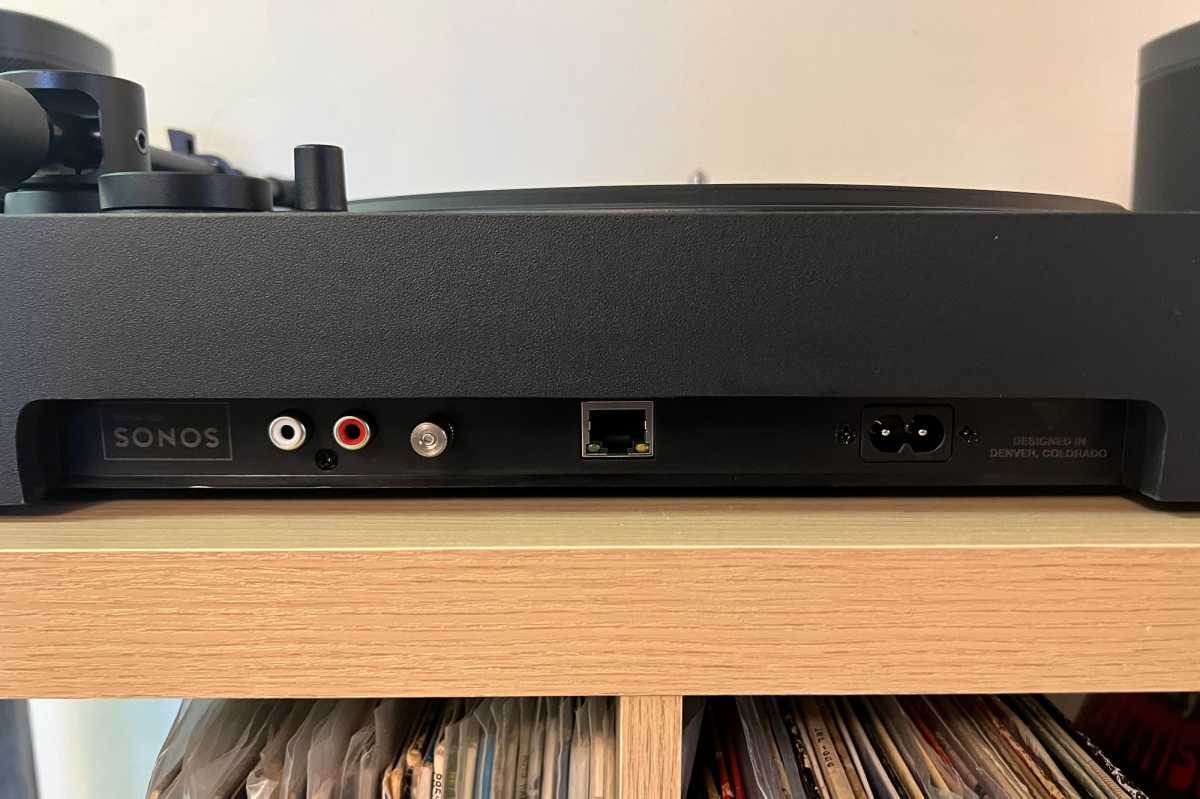
You can use the Victrola Stream Onyx turntable as a traditional wired unit via the RCA jacks on the rear. There’s an RJ45 jack for wired ethernet, too.
James Barber/Foundry
The Victrola Stream Onyx turntable has a remarkably easy setup process with easy-to-follow illustrated instructions. The belt slips over the pulley and the cartridge is pre-mounted on the head shell, so you can just screw on the tonearm retainer ring. The counterweight slips easily onto the back of the tonearm.
You’ll need the Victrola Stream app from the iOS or Google Play app store. Open the app, add the Victrola Stream Onyx, connect it to your Wi-Fi network, and then choose your primary Sonos speaker or group. Turn on autoplay to make the turntable the default source when you’re playing vinyl and you should be set for whenever you want to play records.
I previously had some issues when testing the Carbon turntable, and I was delighted to have my call to the customer service number answered by a person who immediately cleared up my problems by explaining how to do a factory reset on the turntable.
What’s it like to use the Victrola Stream Onyx?
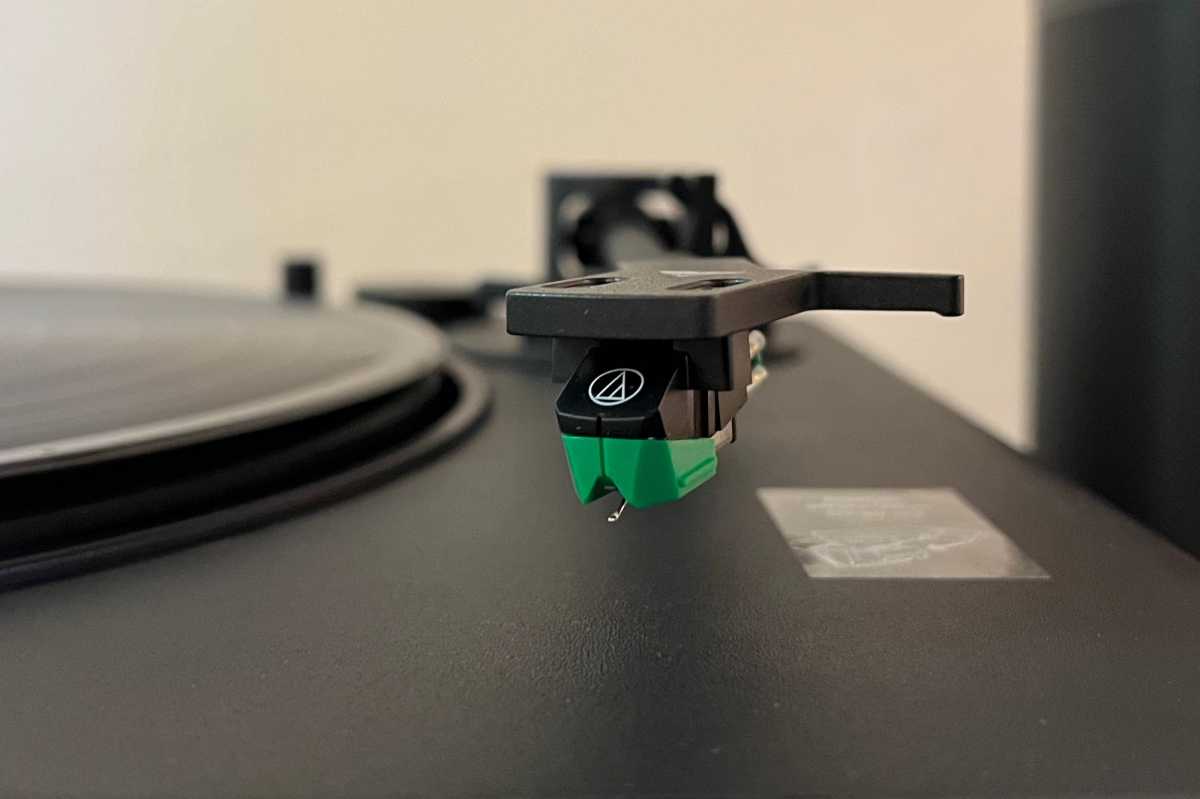
The Victrola Stream Onyx turntable comes with the excellent Audio-Technica AT-VM95E moving magnet cartridge.
James Barber/Foundry
The Stream Onyx automatically connects to your Sonos speakers when you move the cartridge and tonearm from the rest. Lower the stylus to the vinyl and enjoy playback. The turntable will automatically stop spinning when the side finishes playing, and the stylus reaches the runout groove.
The Onyx comes with an Audio-Technica AT-VM95E moving magnet cartridge, which is an outstanding entry-level unit. The turntable plays vinyl at either 33- or 44 rpm once you select your speed with the knob at the back of the plinth, near peg that holds the 7-inch adapter.
The Victrola Stream Onyx measures 4.37 x 16.93 x 13.58 inches (HxWxD) and weighs just over 12 pounds. It has a black front panel and a black metal plinth design. The entire unit is incredibly well made, with few of the plastic parts that make so many other turntables seem cheap.
Victrola has committed to an odd design for its dust covers, which rest flat on the platter with a hood that goes over the tonearm. That means you can’t leave an LP or 45 on the turntable when using the dust cover. A more traditional hinged cover designed to protect the entire surface of the plinth would be more sensible and would also protect your vinyl whether or not the turntable is spinning.
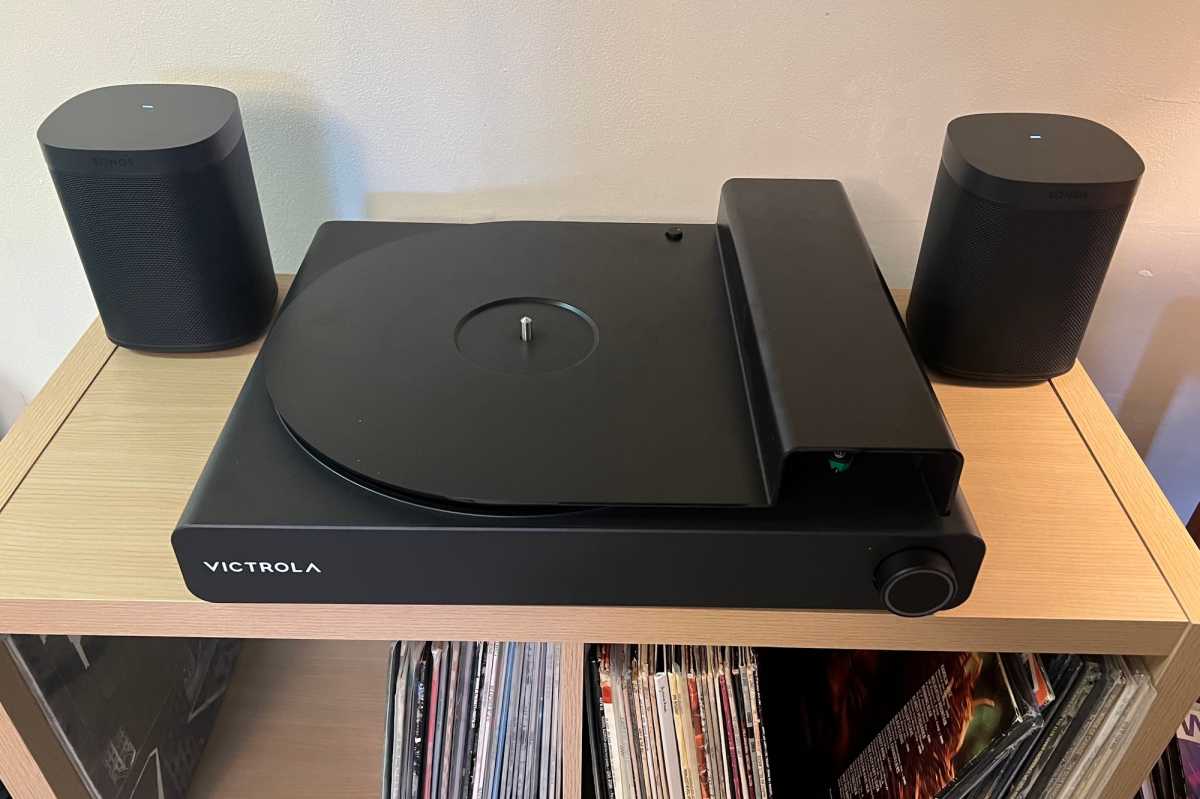
The Victrola Stream Onyx turntable has a dust cover that’s more than a little impractical.
James Barber/Foundry
Sonos uses your home’s Wi-Fi network for streaming, so both the Onyx turntable and your speakers must be connected to the same network. Wi-Fi should offer a higher-quality stream than Bluetooth, but any Sonos setup is subject to dropouts if your Wi-Fi is less than rock-solid.
How does the Victrola Stream Onyx differ from the Stream Carbon?
The Carbon comes with an Ortofon 2M Red moving magnet cartridge, one that sells for $30 more than the Onyx’s Audio-Technica AT-VM95E. The Carbon also has an aluminum headshell instead of a plastic one and a carbon fiber tonearm instead of aluminum. The front piece of the Onyx is black in contrast to the Carbon’s silver panel. Otherwise, the two units seem identical.
You can easily upgrade the cartridge on the Onyx turntable because of its tonearm’s removable head shell, but the difference between the tonearms becomes apparent as you test them side by side. The name tips you off: The carbon tonearm on the Carbon is its most audiophile feature and the more expensive turntable is better able to track warped or noisy vinyl, and the smooth tracking will take less of a toll on your vinyl. You’ll need to decide if those differences are worth an additional $200.
How do records sound on the Victrola Stream Onyx?
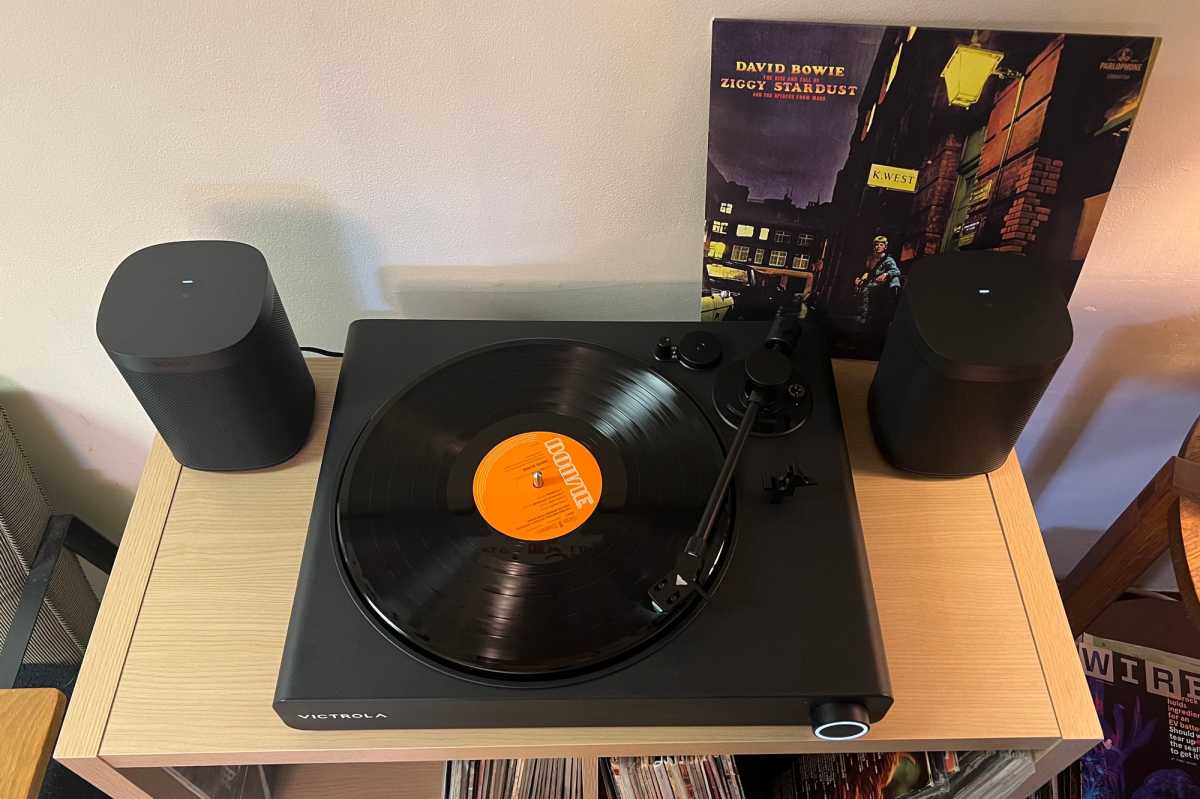
The playback experience with the Victrola Stream Onyx turntable is easy and low stress. Everything works as described.
James Barber/Foundry
I tested the turntable with a brand-new, 180-gram pressing of the 2016 remaster of David Bowie’s 1972 LP The Rise and Fall of Ziggy Stardust and the Spiders from Mars. That’s the same LP I used when previously reviewing the Victrola Stream Carbon turntable.
Did the Carbon’s Ortofon cartridge reveal more details in songs like “Starman” and “Suffragette City” than the Onyx’s Audio-Technica AT-VM95E? Absolutely, but that doesn’t make the AT-VM95E any less of an outstanding entry-level option.
A better (rough) comparison might be between the Onyx and the Monolith 60046 Bluetooth turntable, since both use the Audio-Technica AT-VM95E cartridge. With the Onyx connected to the Sonos and the Monolith turntable connected to an Andover SpinBase Max via Bluetooth, I played the Bowie LP again.
Granted, it’s not an exact match on the speaker end; however, there was noticeably more detail with the Onyx than the Monolith. I generally prefer the Andover speaker to the Sonos pair, so it’s safe to say that the Sonos Wi-Fi connection offers a better wireless streaming experience.
Should you buy the Victrola Stream Onyx turntable?
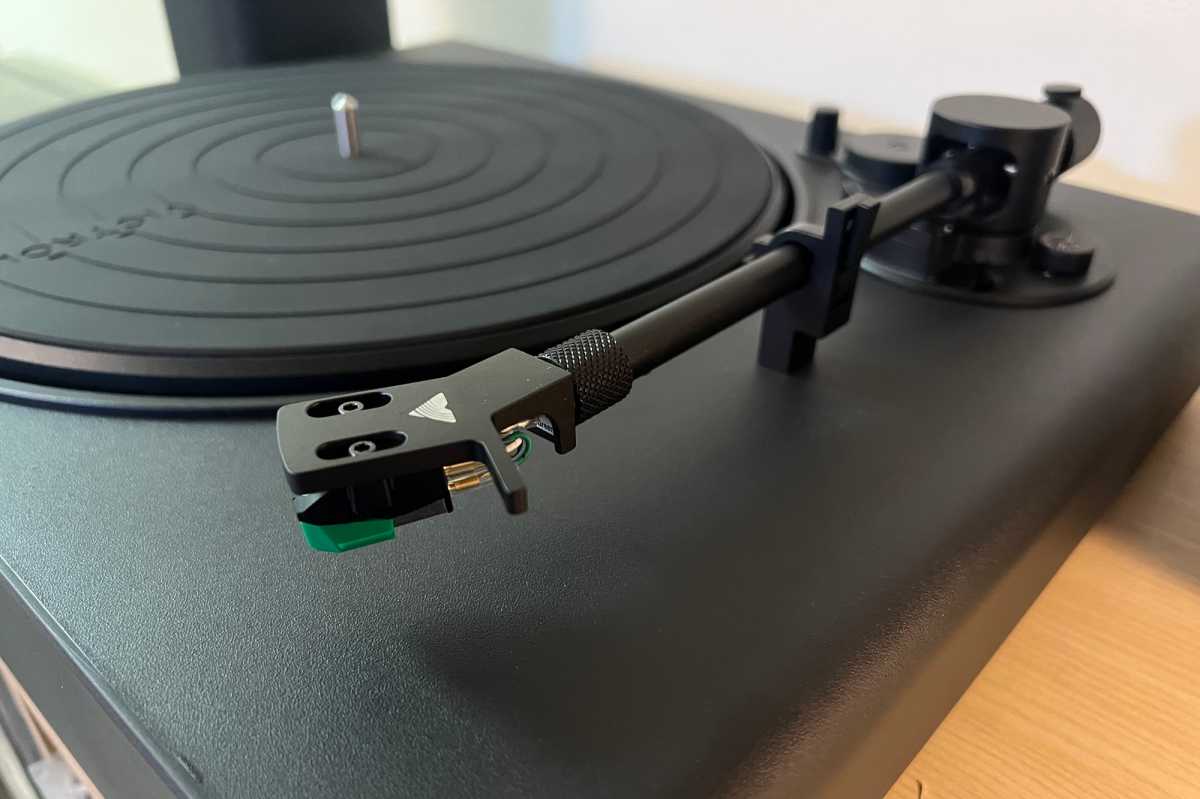
The Victrola Stream Onyx turntable features an aluminum tonearm and a plastic headshell.
James Barber/Foundry
If you own a Sonos setup, the Victrola Stream Onyx turntable offers the least complicated–and least expensive–way to add vinyl to your home listening experience. The turntable is a snap to set up and pair with Sonos speakers and it sounds great.
To get the best vinyl experience, you’ll want a stereo pair of Sonos speakers to get the full effect the artists intended (unless your tastes run to early mono recordings).
Stepping up to the higher-end Stream Carbon is worth the reach if you can swing the $200 premium over this model, but both the Onyx Stream and Carbon Stream are expensive when compared to other models that can’t connect to Wi-Fi. If you’re in the market for the latest Sonos Era speakers, you should at least consider a Bluetooth turntable to go with them–even though Bluetooth won’t deliver as much fidelity as Wi-Fi.
Could you buy a more impressive turntable for $600? Definitely, but that turntable wouldn’t work with Sonos without some expensive upgrades to your Sonos system. The Onyx is certainly the easiest and least costly way to add vinyl to Sonos.




